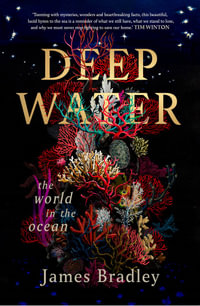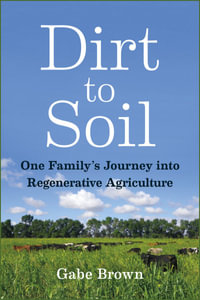
Water Management
Prioritizing Justice and Sustainability
Paperback | 1 October 2024
At a Glance
440 Pages
27.9 x 21.6 x 2.54
Paperback
RRP $103.00
$69.50
33%OFF
or 4 interest-free payments of $17.38 with
orAims to ship in 5 to 10 business days
Drawing on expertise from diverse fields of study, Water Management offers a comprehensive examination of water issues such as prior appropriation, flooding, and famine-perfect for students and professionals looking for a broader view of the subject
Flooding in California. Drought and famine in the Horn of Africa. Massive fish kills in Texas and Australia. "Forever chemicals" in US drinking water. Similar headlines are sure to dominate the news in the years ahead. What is sometimes missing from the headlines, though, is an understanding that these diverse problems are related: manifestations of serious underlying stresses on our water systems. These stresses require sustained attention from water managers, scientists, policymakers, and the public, even after the headlines have faded. That attention, in turn, requires a shared understanding of how water systems function, the problems facing them, and the tools available to increase their resilience.
This text fills that need by providing the necessary knowledge base for understanding and managing complex water problems. It is geared primarily towards students in water management courses at the undergraduate and graduate levels but will also be a helpful resource for practicing water professionals who want to get new ideas or a broader view of the subject.
Rather than focusing on one type of water problem (as many water books do), this text explores the entire gamut of water issues, from dams to desalination, from flooding to famine, from prior appropriation to pumped storage, from sanitation to stormwater. And rather than teaching from one disciplinary perspective (as many water books do), it looks at water problems through a variety of lenses: hydrology, climate science, ecology, and engineering, but also law, economics, history, and environmental justice. The result is a concise yet comprehensive introduction to one of the most critical and demanding challenges of our time: developing just and sustainable solutions to water management.
Industry Reviews
"Shimon Anisfeld's Water Management is the book I wish I had in graduate school! He takes water from the realm of engineering, where decades of technocratic decisions created a legacy of social and environmental challenges, to the real world of today. Anisfeld's well-organized and thorough treatment of how societies manage and use water supplies, and how those management frameworks impact people and nature, is essential reading for everyone working in water and anyone considering a career in this space."
-Jennifer Pitt, Colorado River Program Director, National Audubon Society
"With an even hand and staggering range of knowledge—across time, beyond borders, and deep into every conceivable facet of contemporary water policy—Anisfeld's book slakes a student's thirst to know more and challenges established practitioners to re-engage what they thought they knew, anew. A stunning achievement."
-Laurel Firestone, California State Water Board Member & Co-founder of Community Water Center
"Shimon Anisfeld has written the water law and policy book we need. Centering justice and sustainability, he leads us through the challenges of water availability, quality, and governance. He also recognizes that private and public decision making will be critical to our water future. I could not recommend this book more highly for the novice or the expert; it is beautifully written with ample visual aids that will make it easily accessible for all."
-Gerald Torres, Professor of Environmental Justice and Professor of Law, Yale University
"Completely authoritative yet fully engaging for a broad audience, Water Management is destined to be the definitive textbook about how to sustainably manage our most precious of resources for years to come. A must read for students, practitioners, and activists."
-Alon Tal, author of Making Climate Tech Work
Contents
Preface
Acknowledgments
Units and Conversions
Chapter 1: Introduction
1. The Great Acceleration and the Just Transition
2. The Centrality of Water
-2.1. Water and the Human Spirit
-2.2. Water as a Human Right
-2.3. Water Use
-2.4. Water as a Resource
-2.5. Water and Global Development
-2.6. The Water-Energy Nexus
-2.7. Water and Ecosystems
3. The Water Hard Path and the Global Water Crisis
4. A Water Ethic: Justice and Sustainability
-4.1 Justice
-4.2 Sustainability
5. How We Get There: Infrastructure, Institutions, Incentives, and Information
PART I: Water Availability and Use: Supply and Demand, Scarcity and Change
Chapter 2: Water Availability: Spatial and Temporal Variability
1. Global Stocks and Flows
2. Spatial Variation in Water Availability
3. Temporal Variation in Water Availability
-3.1. Hydrographs
-3.2. Flow Duration Curves
-3.3. Flood Frequency Analysis
-3.4. Rainfall Intensity-Duration-Frequency Curves
4. Drought
-4.1. Defining Drought
-4.2. Causes of Drought
-4.3. The Great Drought and the Dust Bowl: The Role of Management
-4.4. Paleoclimatology and Megadroughts
Chapter 3: Global and Local Change: The End of Stationarity
1. Climate Change
-1.1. Theory and Prediction
-1.2. Observation
-1.3. Indirect Effects
2. Land-Use Change
-2.1. Deforestation: Watershed Effects
-2.2. Deforestation: Impacts on Precipitation
-2.3. Managing Forests for Water Supply
-2.4. Desertification
-2.5. Urbanization
3. Managing Change
Chapter 4: Water Use: From Ancient to Modern Times
1. Premodern Agriculture
-1.1. Large-River Irrigation
-1.2. Small-River Irrigation
-1.3. Runoff Farming
-1.4. Groundwater Use
-1.5. Wetlands and Springs
-1.6. Water Storage
2. Premodern Urban Water Supply
3. Modern Water Management
-3.1. The Hard Path
-3.2. US Water Management: From Hard to Soft
-3.3. Water in the Global Development Agenda
4. Water Use in the Modern Era: A Quantitative Analysis
-4.1. Definitions
-4.2. Water Footprints
-4.3. Global and US Water Use
Chapter 5: Water Scarcity and Depletion: Are We Reaching the Limits of Our Supply?
1. Scarcity Indicators
-1.1. Falkenmark and WTA Indicators
-1.2. Incorporating Environmental Flows
-1.3. Utility Shortage
-1.4. Economic Water Scarcity
2. Assessing Water Scarcity
3. Surface Water Depletion
-3.1. Shrinking Lakes
-3.2. River Depletion and Altered Flow Regimes
4. Groundwater Use and Overuse
-4.1. Groundwater Pumping
-4.2. The Extent of Groundwater Depletion
-4.3. Groundwater Depletion in California's Central Valley
5. Managing Water Scarcity
PART II: Instream Water Management: Rivers and Dams, Flooding and Hydropower
Chapter 6: Instream Uses: Navigation, Hydropower, Fishing, and Recreation
1. Navigation
2. Water Power
-2.1. History of Water Power
-2.2. Hydroelectric Power
-2.3. Hydropower: Renewable Energy?
-2.4. Sustainable Hydropower
3. Fishing
4. Recreation
Chapter 7: Flood Management: Learning to Live With "Too Much" Water
1. Types of Floods
2. Flooding Impacts and Trends
3. Flood Hazard
4. Flood Exposure
5. Flood Vulnerability
-5.1. Structural Flood Control
-5.2. The Levee Effect: The Illusion of Dryness
-5.3. Benefit-Cost Analysis
6. The Way Forward
-6.1. Building in Floodplains: The Problem
-6.2. The NFIP: The Solution?
-6.3. Buyouts and Managed Retreat
Chapter 8: Water Quality and the Clean Water Act
1. Water Quality and Health
2. The Clean Water Act
-2.1. Addressing Chemical Pressures
-2.2. Defining and Meeting Water Quality Goals
-2.3. Incorporating Nonchemical Stressors
-2.4. Effectiveness of the Clean Water Act
3. Other US Environmental Laws
Chapter 9: Dams and Their Discontents: Are the Benefits Worth the Costs?
1. Dam Basics
-1.1. Types of Dams
-1.2. Dam Components and Terminology
-1.3. Managing Reservoirs for Multiple Purposes
-1.4. Reservoir Storage-Yield Relationships
2. The Dam Debate: The Changing Attitudes of the Past Century
-2.1. The Dam-Building Era(s)
-2.2. From Zeal to Skepticism in the Twentieth Century
-2.3. The World Commission on Dams and Its Aftermath
3. Snapshot of US and Global Dams
-3.1. How Many Dams Are There?
-3.2. What Are Dams Used For, and Who Manages Them?
-3.3. How Has Storage Volume Changed Over Time?
4. Ecological Impacts of Dams
5. Social Impacts of Dams
-5.1. Population Displacement
-5.2. Dam Safety
6. Building the Right Dams and Managing Them the Right Way
-6.1. Building Better Dams
-6.2. Managing Dams Better
7. Dam Removal
8. Aqueducts
PART III: Water Governance: Allocation and Reallocation, Cooperation and Conflict
Chapter 10: Water Allocation: Sharing the Common Pool
1. Water as a Common-Pool Resource
-1.1. Economic Efficiency in Water Allocation
-1.2. CPRs and the Tragedy of the Commons
-1.3. Ostrom and Community Management
2. Water Allocation in the United States
-2.1. The Riparian Doctrine
-2.2. Regulated Riparianism
-2.3. Prior Appropriation
-2.4. Groundwater Allocation
-2.5. Reserved Rights
-2.6. Interstate Water Allocation
Chapter 11: Reallocation and Coordination for Improved Water Governance
1. Reallocation for Cities, Tribes, and the Environment
-1.1. Water Markets
-1.2. Negotiating Ag-to-Urban Reallocation
-1.3. Environmental Flow Requirements
-1.4. Legal Tools for EFRs
-1.5. WaterBack: Decolonizing Water Management
2. Coordination and Planning
-2.1. State Coordination and Planning
-2.2. Interstate Coordination and Planning
Chapter 12: Transboundary Water Management: Conflict and Cooperation
1. Introduction to Water Conflict
2. International Basins and Aquifers
-2.1. The Extent of Transboundary Waters
-2.2. International Law of Transboundary Waters
-2.3. Water Wars or Water Peace?
-2.4. Drivers of Water Conflict
-2.5. Building Institutional Resilience
3. Nonstate Water Conflicts
PART IV: Offstream Water Use: Cities and Farms, Mines and Factories
Chapter 13: Beyond Dams: Old and New Solutions for Water Supply
1. Desalination
2. Wastewater Reuse
3. Water Harvesting
4. Aquifer Storage
5. Energy for Water Supply
6. Summary
Chapter 14: Drinking Water, Sanitation, and Health: Water 3.0
1. Water and Infectious Disease
2. History of Urban Water and Sanitation
-2.1. Ancient and Medieval Sanitation and Drainage
-2.2. Epidemics and the Sanitary Revolution
-2.3. The American Experience
3. Water 3.0: Drinking Water and Sanitation in the US
-3.1. Defining Safe Drinking Water
-3.2. Source Protection
-3.3. Water Treatment
-3.4. The Distribution System
-3.5. Urban Sanitation
-3.6. Combined Sewers
-3.7. Rural Sanitation
4. Evaluating Water 3.0
-4.1. Health Effects
-4.2. Disparities in Access
-4.3. Utility Structure
-4.4. The Rise of Bottled Water
-4.5. The Problem of Linear Flows
Chapter 15: Urban Water Management: Water Conservation, Stormwater Management, and Beyond
1. Defining and Achieving Reliability
2. Conservation
-2.1. How Much Do We Use?
-2.2. Tools for Conservation
3. Pricing
-3.1. Cost Recovery
-3.2. Conservation
-3.3. Affordability
-3.4. Rate Structures
4. Reuse and Decentralization
5. Urban Stormwater Management
-5.1. Stormwater and the Urban Stream Syndrome
-5.2. Urban Stream Restoration
-5.3. Legal and Financial Tools for Stormwater Management
Chapter 16: Water, Sanitation, and Health in Low- and Middle-Income Countries: Leaving No One Behind
1. Water and Sustainable Development
-1.1. The Burdens of Inadequate WASH
-1.2. WASH Goals
2. Drinking Water
-2.1. From Goals to Indicators
-2.2. Where We Stand
-2.3. Affordability
3. Sanitation
-3.1. Sanitation Solutions
-3.2. From Goals to Indicators
-3.3. Where We Stand
4. Hygiene
5. The Way Forward
6. WASH Funding
-6.1 Tariffs
-6.2 Taxes
-6.3 Transfers
Chapter 17: Industrial Water Use: Our Invisible Water Footprints
1. Water for Energy
-1.1. Water for Electricity
-1.2. Water for Transportation
-1.3. Pollution from Energy Production
2. Water for Manufacturing
-2.1. Direct Water Use
-2.2. Upstream and Downstream Water Use
-2.3. Pollution from Manufacturing
3. Water and Mining
4. Corporate Water Stewardship
Chapter 18: Agricultural Water Use: Water's Central Role in Our Food Supply
1. From the Green Revolution to Sustainable Intensification
2. Water and Agriculture: Overview
-2.1. Water Use in Global Agriculture
-2.2. How Much Agricultural Water Do We Need?
3. What We Eat
-3.1. Water Footprints of Various Foods
-3.2. Animal Products: A Closer Look
-3.3. Sustainability of Blue Water Use
4. Where We Grow It
5. How We Use Water
-5.1. Irrigation
-5.2. Rainfed Agriculture
6. Pollution
-6.1. Salinization
-6.2. Nutrient Pollution from Croplands
-6.3. Pollution from Animal Feeding Operations
Abbreviations
Glossary
About the Author
References
Index
ISBN: 9781642830057
ISBN-10: 1642830054
Published: 1st October 2024
Format: Paperback
Language: English
Number of Pages: 440
Audience: Professional and Scholarly
Publisher: ISLAND PRESS
Country of Publication: US
Dimensions (cm): 27.9 x 21.6 x 2.54
Weight (kg): 1.11
Shipping
| Standard Shipping | Express Shipping | |
|---|---|---|
| Metro postcodes: | $9.99 | $14.95 |
| Regional postcodes: | $9.99 | $14.95 |
| Rural postcodes: | $9.99 | $14.95 |
How to return your order
At Booktopia, we offer hassle-free returns in accordance with our returns policy. If you wish to return an item, please get in touch with Booktopia Customer Care.
Additional postage charges may be applicable.
Defective items
If there is a problem with any of the items received for your order then the Booktopia Customer Care team is ready to assist you.
For more info please visit our Help Centre.
You Can Find This Book In
This product is categorised by
- Non-FictionEarth Sciences, Geography, Environment, PlanningThe EnvironmentConservation of The Environment
- Non-FictionEarth Sciences, Geography, Environment, PlanningThe EnvironmentEnvironmental Management
- Non-FictionEngineering & TechnologyEnvironmental ScienceSanitary & Municipal EngineeringWater Supply & Treatment
- Non-FictionEarth Sciences, Geography, Environment, PlanningThe EnvironmentSustainability























